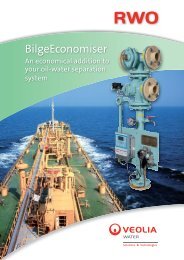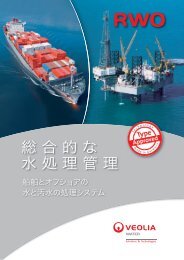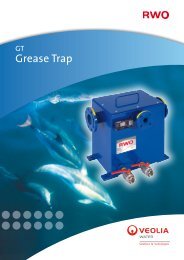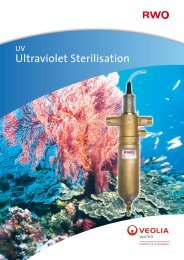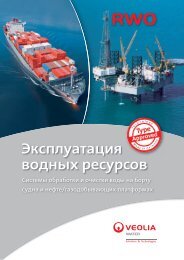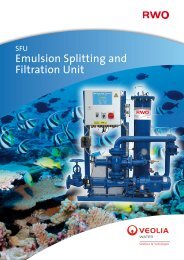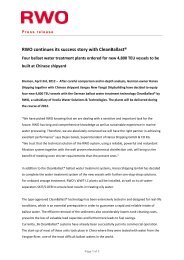the IHS Ballast Water Guide - RWO Marine Water Technology
the IHS Ballast Water Guide - RWO Marine Water Technology
the IHS Ballast Water Guide - RWO Marine Water Technology
You also want an ePaper? Increase the reach of your titles
YUMPU automatically turns print PDFs into web optimized ePapers that Google loves.
<strong>IHS</strong> Fairplay Solutions <strong>Guide</strong> to <strong>Ballast</strong> <strong>Water</strong> Treatment Systems Sponsored by<br />
is controlled by remote automated control<br />
system of valves, which can permit <strong>the</strong> tanks<br />
to be treated sequentially or all at once.<br />
Sensors detect <strong>the</strong> amount of dissolved<br />
oxygen in <strong>the</strong> ballast water and <strong>the</strong> pH level<br />
of each tank, and relay <strong>the</strong> information to a<br />
central control station.<br />
This inert gas has all <strong>the</strong> ingredients<br />
necessary to combine <strong>the</strong> two treatments of<br />
hypoxia and carbonation at what is claimed as<br />
a very reasonable cost, as analysis has shown<br />
that given <strong>the</strong> flow rates and control time for<br />
hypoxia carbonated conditions, <strong>the</strong> gas needs<br />
only a short contact time to be effective.<br />
Fine <strong>Ballast</strong><br />
Mitsui Engineering/MOL/<br />
MOL <strong>Marine</strong> Consulting<br />
The system employs <strong>the</strong> synergistic effect of<br />
chemical treatment by <strong>the</strong> oxidation power<br />
of <strong>the</strong> active ingredient ozone and physical<br />
treatment using a specially designed pipe<br />
placed in <strong>the</strong> ballast water piping lines.<br />
The organisms are killed off once only, at<br />
<strong>the</strong> time <strong>the</strong> ballast water tanks are filled.<br />
The system extracts <strong>the</strong> required amount<br />
of ozone from <strong>the</strong> air. As <strong>the</strong> right amount<br />
is produced, MOL maintains <strong>the</strong>re is no<br />
requirement for a chemical agent for ozone<br />
supply or storage.<br />
Micro bubbles of ozone are injected into<br />
<strong>the</strong> system, which achieves high efficiency<br />
levels for absorption and contact against <strong>the</strong><br />
plankton and bacteria. Harmful substances<br />
remaining in ballast water are extracted by<br />
activated charcoal, which has no impact on<br />
<strong>the</strong> environment.<br />
The system was audited according to G8<br />
guidelines. Certification involved a full-scale<br />
land-based test of <strong>the</strong> system carried out by<br />
Mitsui Engineering & Shipbuilding and o<strong>the</strong>r<br />
participant companies toge<strong>the</strong>r with an<br />
8<br />
onboard test on <strong>the</strong> MOL-operated container<br />
vessel MOL Express.<br />
The system acquired <strong>the</strong> final approval under<br />
G9 guidelines at <strong>the</strong> end of September ptembe be ber 2010 20 2010. 10 10.<br />
VOS<br />
NEI Treatment Systems<br />
6 5<br />
Venturi oxygen stripping (VOS) methodology<br />
and an inert gas generator (IGG) are employed<br />
in NEI’s system. The very-low-oxygen inert<br />
gas is educed into unfiltered influent ballast by<br />
means of venturi injectors.<br />
When exposed to <strong>the</strong> low-oxygen gas,<br />
dissolved oxygen in <strong>the</strong> ballast water is<br />
stripped out of solution, leaving <strong>the</strong> ballast<br />
water deoxygenated and effectively sterilised.<br />
When deballasting, ballast tanks are filled<br />
with inert gas to maintain <strong>the</strong>m as a lowoxygen<br />
environment. This actively reduces<br />
corrosion and coating breakdown in <strong>the</strong><br />
ballast tanks.<br />
The VOS system can be installed aboard any<br />
type of vessel. For a 1,000m 3 /h system, <strong>the</strong><br />
system has a footprint of approximately 4m 2 ,<br />
while a 4,500m 3 /h system has a footprint<br />
of approximately 10m 2 . It does not require<br />
filters or chemical addition and can handle<br />
very large flow rates without large power<br />
usage –



